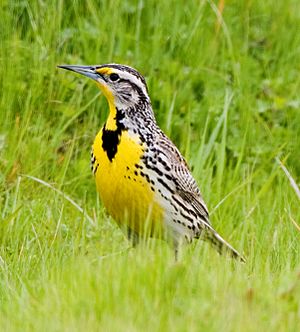Western Meadowlark facts for kids
The Western Meadowlark is a beautiful bird known for its bright yellow belly and clear, flute-like song. It lives in grasslands and open fields across the middle-western USA. This special bird is so loved that it's the state bird for six different states: Kansas, Montana, Nebraska, North Dakota, Oregon, and Wyoming.
Contents
What Does a Western Meadowlark Look Like?
Western Meadowlarks are medium-sized birds, about 8 to 11 inches (20 to 28 cm) long. They have a striking appearance. Their chests and bellies are bright yellow, with a bold black "V" shape across their chest. Their backs are streaked with brown and black, helping them blend into the grass.
They have long legs and a fairly long tail. Their beaks are pointed, which is useful for finding food. When they fly, you can see white outer tail feathers, which is a good way to tell them apart from other birds.
Where Do Western Meadowlarks Live?
Western Meadowlarks prefer open areas like prairies, grasslands, and pastures. They can also be found in fields where crops are grown, as long as there is enough open space. They live in many parts of western North America.
These birds spend most of their time on the ground. They walk or run through the grass looking for food. They are often hard to spot because their brown backs help them hide in their grassy homes.
What Do Western Meadowlarks Eat?
Western Meadowlarks are omnivores, meaning they eat both plants and animals. Their diet changes with the seasons. In the summer, they mostly eat insects. This includes grasshoppers, crickets, beetles, and caterpillars. Insects provide them with lots of energy.
In the colder months, when insects are harder to find, they switch to eating seeds and grains. They might eat seeds from weeds or leftover grains from farm fields. Their diet helps them stay healthy all year round.
What Does a Western Meadowlark Sound Like?
The song of the Western Meadowlark is one of its most famous features. It has a clear, flute-like whistle that sounds very cheerful. People often describe it as a series of clear, descending notes. It's a sound that many people connect with open fields and the American West.
Males sing to attract mates and to mark their territory. They often sing from a high perch, like a fence post or a tall bush. They also have a different call, a dry, chattering sound, which they use to warn others of danger.
Life Cycle and Reproduction
Western Meadowlarks usually build their nests on the ground. The female builds a cup-shaped nest, often hidden in a small dip or under a clump of grass. She weaves grasses and plant stems together. Sometimes, she even builds a little dome or tunnel over the nest to keep it extra hidden and safe.
The female typically lays 3 to 7 eggs. The eggs are white with brown or purple spots. She sits on the eggs to keep them warm until they hatch, which takes about 13 to 16 days. Once the chicks hatch, both parents help feed them. The young birds grow quickly and are ready to leave the nest in about 10 to 12 days.
Interesting Facts About Western Meadowlarks
- Western Meadowlarks are not actually larks. They belong to the blackbird family!
- They are known for their "broken-wing display." If a predator gets too close to their nest, the adult bird might pretend to have a broken wing. This tricks the predator into chasing the adult bird away from the nest, keeping the chicks safe.
- These birds are important for controlling insect populations in agricultural areas because they eat so many insects.
Images for kids
See also
 In Spanish: Turpial gorjeador para niños
In Spanish: Turpial gorjeador para niños



